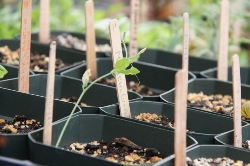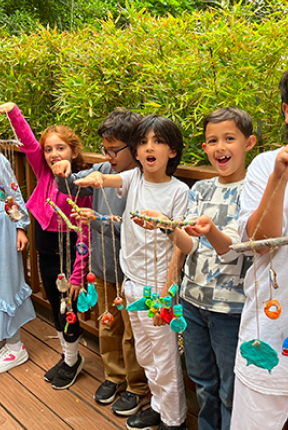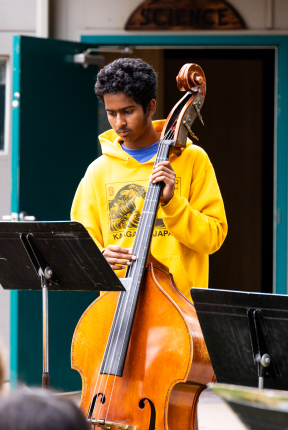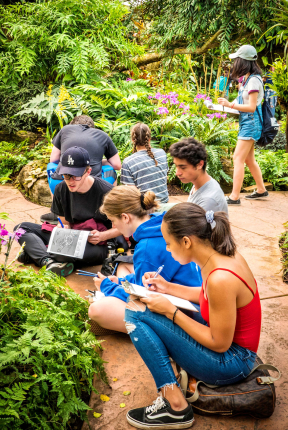Gardening class teacher Bridget Kelley summarizes the various projects that grades 1-8 have been working on this year. It is quite surprising to realize how much is taught in this class and how much our students have accomplished.
1st Grade
In the early grades, the intention in gardening class is to experience nature through all the senses and to expose the children to the cycles and patterns of nature such as weather, seasons, growth and decay.
At the beginning of the year, the children were introduced to the farm space through the planting and tending of our vegetables and flowers. They planted from starts as well as seeds. Many of the fruits of their labors were harvested and enjoyed during our garden walks and salad parties, including some delicious lettuce, carrots and snap peas. We reviewed proper farm etiquette in every class, including the importance of treating other living things gently and respectfully.
Fairy houses were created and lovingly tended around the orchard. Seasonal craft projects were undertaken as well, including leaf prints, pinecone birdfeeders, and homemade seed paper. Along the way compost was sifted, leaves were raked, weeds were pulled, mulch was hauled, seeds were collected, chickens were fed, and the garden was kept well watered and cared for by these young gardeners.
2nd Grade
Second grade is an important year for establishing solid work ethics, and the children worked very hard indeed! They also strove to learn proper farm etiquette: respect each other and the plants and animals on the farm, walk on the paths and not in the beds, handle tools safely, put away tools at the end of class, and always ask permission before picking fruits or vegetables.
They helped our gardens grow by planting and tending beds of broccoli, beets, Swiss chard, and carrots. Harvest parties were a big hit and every student declared a love for freshly harvested salad greens and snap peas. The children also explored and worked on our beloved butterfly habitat: collecting and saving native milkweed seeds, looking for monarch caterpillars and milkweed bugs and watching butterflies emerge from their cocoons. Bug checks were a favorite activity where we learned the difference between beneficial and harmful bugs in the garden.
We also enjoyed garden crafts in the winter such as decorating “stained glass” pots, making native flower seed balls, creating seed tape, and pressing homemade paper for Valentine’s day. This spring we made our own wooden flower presses.
3rd Grade
An important goal of 3rd grade gardening is for the children “to learn to connect themselves consciously with their surroundings” and suggests that they learn to till the soil, distinguish between the different kinds of grain, and learn about the relationships between plant, animal and the human being. This helps them develop the security and confidence needed for life on earth.
It has been a busy year on the farm, starting last summer when they helped prepare the row beds for planting grains. In the fall, they harvested buckwheat which was threshed, winnowed and ground into flour for delicious buckwheat pancakes. They did the same with our bountiful sesame harvest which was made into halvah and tahini dressing. At Michaelmas, they planted flax which was later processed into flax fibers with Ms. Lewis. Other fall plantings included kale, sugar snap peas, garlic, collards, beets, carrots, and winter wheat. In winter, they made seed balls and seed tape in preparation for the spring. In spring, they planted tomatoes, cucumbers, peppers and basil. At the end of the school year, they harvested the wheat and carefully processed it into flour to make pizza in our outdoor bread oven.
Throughout the school year, they worked hard at planting, hoeing, raking, amending, weeding and mulching. Proper use of tools and appropriate garden etiquette was emphasized in every class. They helped build several large biodynamic compost heaps and led our school composting program by gathering compost from the lower classes each week and incorporating it into the compost piles.
4th Grade
In conjunction with the Man and Animal studies in most Waldorf schools, 4th grade gardening focuses on the abundant animal life on our farm. The children learned how to care for our chickens, and helped keep our hens healthy and laying eggs throughout the year. Sales of our eggs help to support our farm and keep it growing.
In the fall we built a large and productive worm bin which gave us an opportunity to study worms and other critters up close while learning about the important process of composting.
In the winter we learned about bird watching and were treated to a rare visitation by a large colony of turkey vultures in the wooly woods. We also enjoyed spotting our Cooper’s Hawks and Red Tailed Hawks among many other local bird species.
We planted native milkweed and other butterfly-attracting plants in our monarch sanctuary at the center of the farm. We also built pollinator boxes with the hope of attracting other native bees such as mason and carpenter bees to our orchard. In the spring we spotted dozens of monarch caterpillars and had the opportunity to watch the stages of metamorphosis into adult butterflies.
We also learned about honey bees and beekeeping and built frames and boxes for a new beehive. We’re looking very forward to harvesting honey next year! Proper care and usage of farm tools was emphasized in every class, along with regular review of our garden rules
5th Grade
In conjunction with the 5th grade botany studies, the students worked diligently in the plant nursery learning how to successfully start plants from seed. They learned about different soil mediums and propagation techniques, as well as organic methods of controlling garden pests. We are now enjoying an abundance of flowers throughout the farm which the students started by seed early in the school year.
The 5th graders also started beds of kale, broccoli, cauliflower, cabbage, garlic and carrots in the fall which produced delicious crops through late winter and spring. The Wednesday group regularly helped prepare our harvests for sale at our weekly farm stand. In the winter they helped build our biodynamic compost piles, made compost tea and prepped beds for planting lettuce and peas. Proper use of garden tools and appropriate garden etiquette were emphasized in every class.
6th Grade
The sixth grade gardening class was introduced to herbal medicine this year, where they learned about the healing properties of some of our garden plants. They spent several weeks preparing topical healing salves from harvested plantain and calendula. They also helped add several new perennials to our medicinal herb garden, all of which were started from seed in the fall.
In conjunction with the sixth grade geology block, the students analyzed soil samples taken around the farm and calculated the percentage of clay, sand and silt. They also learned the importance of compost in improving the tilth of existing soil.
Other projects included mulching the fruit trees in the orchard; building low tunnels from PVC to protect seedlings from frost; planting flower bulbs; and starting beans, shallots and kale. They were instrumental in replanting our beloved LA Wildflowering bed on the corner of Superior and Amestoy. They especially enjoyed our cooking activities such as making pesto, vegetable stir-fries and sauerkraut. All of our ingredients were harvested from our garden.
Proper care and usage of farm tools was emphasized in every class, along with regular review of our garden rules. They also kept garden journals of their activities throughout the school year.
7th Grade
The 7th grade curriculum includes a block in nutrition and many of our classes focused on the culinary uses of the vegetables and herbs in our garden. In our greenhouse work we started annual kitchen herbs (thyme, cilantro, parsley) from seed and perennials (rosemary and sage) by propagation. We then cleaned up the kitchen herb garden to prepare for transplanting our seedlings. The students regularly helped with harvesting for our weekly farm stand in the fall, which included tomatoes, peppers, eggplants, and squash. They also learned how dry herbs for tea and to prepare pesto from our farm-raised basil and garlic.
Another aspect of 7th grade gardening was learning the importance of saving seeds. We harvested and cleaned seeds from several of our dye & fiber plants and packaged them in handmade origami envelopes to sell at the Winter Faire. Just before the holiday break, we did a bit of community service as “flower fairies” by planting dozens of daffodil and naked lady bulbs around campus.
8th Grade
In the 8th grade, students were introduced to the concepts of sustainability and permaculture through a series of farm-based projects which increased in complexity as the year progressed. In addition, the students were taught the proper use of various power tools. They also learned the proper care and maintenance of our garden tools.
Projects this year included designing and painting signs for the newly built compost corrals, designing and building a large planter bed for native berries (using materials salvaged on campus), building a vertical succulent garden from pallets, building tomato trellises from concrete reinforcement mesh, replanting the kindergarten vegetable beds, renovating our existing chicken tractor, and designing and building a portable chicken tractor from scratch. We had a few harvest parties along the way and enjoyed some delicious stir fries and salads.






